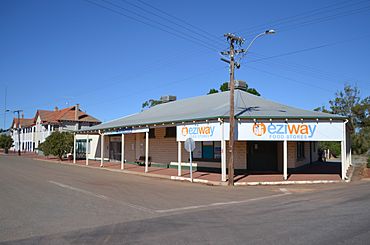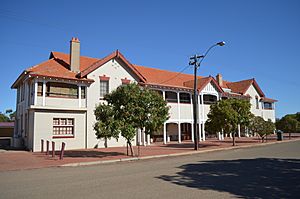Coorow, Western Australia facts for kids
Quick facts for kids CoorowWestern Australia |
|
|---|---|

Main Street, Coorow, 2013.
|
|
| Established | 1893 |
| Postcode(s) | 6515 |
| Elevation | 272 m (892 ft) |
| Area | [convert: needs a number] |
| Location | |
| LGA(s) | Shire of Coorow |
| State electorate(s) | Moore |
| Federal Division(s) | Durack |
Coorow is a town located in the Mid West area of Western Australia. It is about 264 kilometres (164 mi) north of Perth, a major city.
Contents
History of Coorow
How Coorow Got Its Name
The town of Coorow officially started in 1893. Its name comes from an Aboriginal word. This word was first written down in 1872. It was the name of a spring nearby.
Some people think the name "Coorow" comes from "Curro." This is an Aboriginal word for a type of plant called Portulaca. Others believe the name means "many mists."
Early Floods in Coorow
In 1918, Coorow had some flooding. This happened after a lot of rain fell overnight. About 2.53 inches (64 mm) of rain came down. The Moore River overflowed its banks. This caused even worse flooding further downstream in Moora.
Building the Coorow Hotel
After the town grew quickly in the early 1920s, local people wanted a hotel. They started trying to get a hotel licence in 1927. The licence was given in 1929 to Alexander Gloster. He offered £1,750 and showed his building plans.
The hotel cost £13,000 to build. It was made from cement blocks and brick. This large building had two floors. The top floor had fifteen rooms for guests. The ground floor had more rooms, a kitchen, a bar, and a laundry. The hotel also had plumbing for hot and cold water. It even had its own power plant for electricity.
Grain Storage for Farmers
In 1932, the Wheat Pool of Western Australia made an announcement. They said Coorow would get two large grain storage buildings. These buildings are called grain elevators. Each one would have an engine. They were built next to the railway line. This helped farmers store their crops.
More Flooding in 1932
Coorow was flooded again in 1932. This was after very heavy rains in the area. The town was underwater for at least a day. Luckily, the water quickly flowed away into the Moore River. People worried that the town's dam might break from the water pressure.
Roads were cut off by water washing them away. The streets and flooded buildings were left covered in deep mud. Some farm animals, mostly sheep, were lost during this flood.



